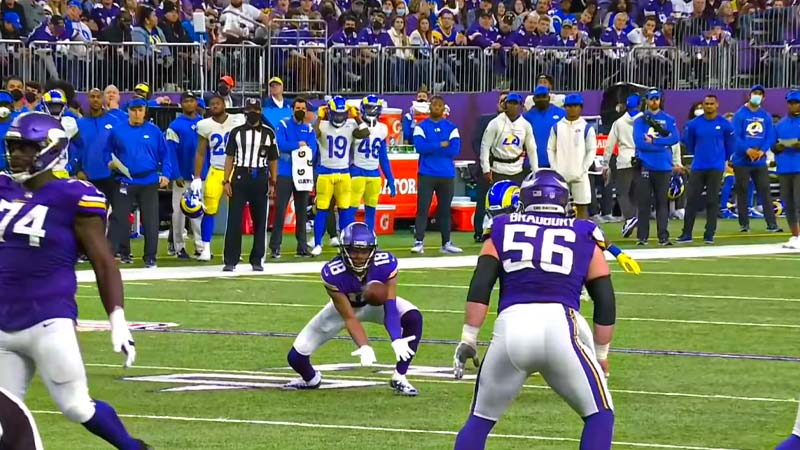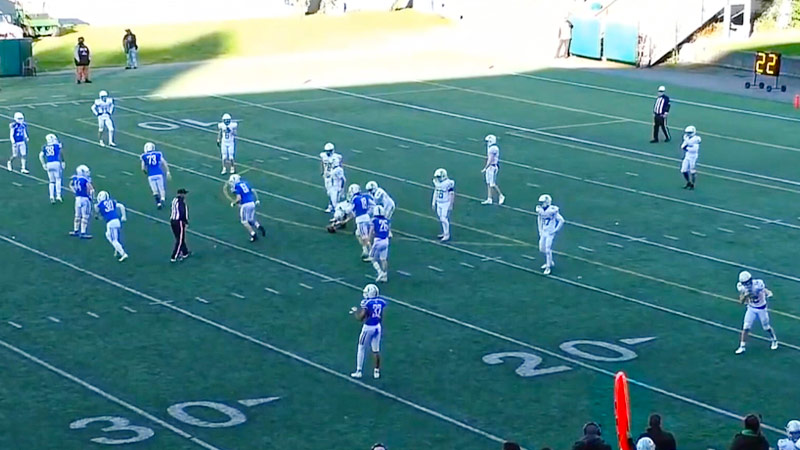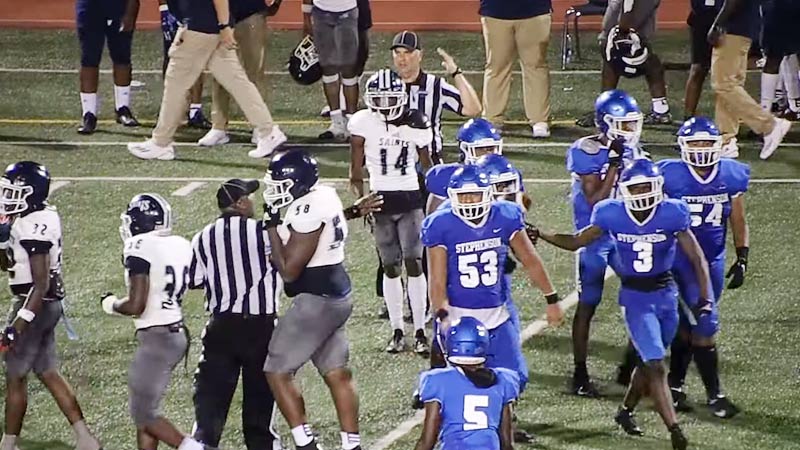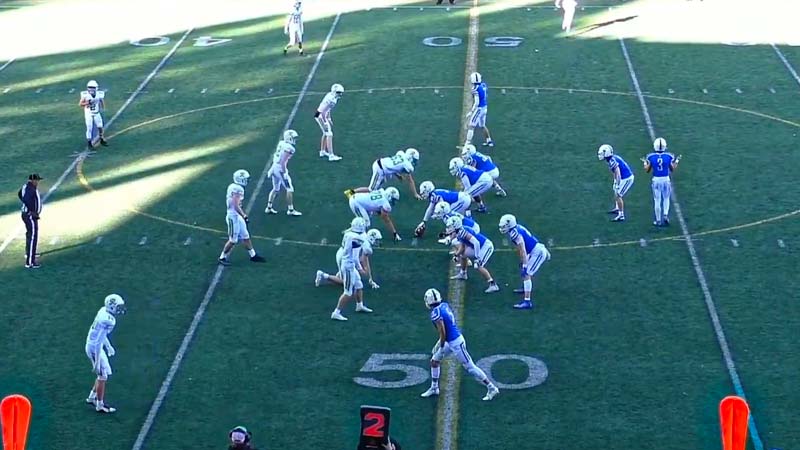Football, a game of strategy, skill, and intensity, is a sport that has captured the hearts of millions around the world. Within its intricate tapestry of plays and formations, one element stands out as a pivotal tool for coaches and teams: substitution rules.
In American football, these rules dictate when and how players can be replaced on the field, profoundly impacting the course of the game.
In this guide, we delve into the nuances of football substitution rules, exploring the what, why, and how behind this crucial aspect of the sport. So, stay focused.
What Is Substitution in Football?
Substitution in American football refers to the strategic replacement of players on the field during a game. Coaches utilize substitutions to optimize their team’s performance by sending in players with specific skills for different situations.
Substitutions can occur during stoppages in play, such as timeouts, between plays, or at the end of quarters. This allows teams to adjust their lineup based on offensive, defensive, or special teams requirements.
Substitutions enable fresh and specialized players to be introduced, maintaining peak performance levels and preventing fatigue. The process involves players leaving the field and their replacements entering, ensuring teams have the right personnel for varying game scenarios.
Effective substitution strategies contribute significantly to a team’s overall success by adapting to the evolving dynamics of the game.
Football Substitution Rules
In American football, substitution rules govern how players can be replaced on the field during a game. These rules aim to maintain fairness, safety, and strategic gameplay. Here are some key points regarding substitution rules in American football:
Unlimited Substitutions
Unlike many sports, American football allows for unlimited substitutions. This means coaches can swap out players freely between plays, timeouts, or other stoppages in the game.
Dead Ball Substitutions
Substitutions are typically made during dead ball situations, which occur when the ball is not in play. This includes moments like timeouts, between quarters, after touchdowns, and during injuries.
Offense and Defense
Teams can substitute players for both offensive and defensive positions. This flexibility enables coaches to adjust their lineup to match the specific situation, such as bringing in larger defensive linemen to stop a short-yardage run.
Special Teams
Substitutions are especially prevalent during special teams plays, such as kickoffs, punts, and field goal attempts. Teams often have specialized players for these situations, requiring quick and strategic changes.
Quarterback Substitution
Quarterback substitutions are crucial, as they can influence a team’s offensive strategy significantly. Teams may switch quarterbacks based on performance, game situation, or injury.
Hurry-Up Offense
In the hurry-up offense, teams aim to maintain a fast pace to catch the defense off guard. Substitutions can be limited during this tactic to prevent the defense from making advantageous changes.
Injury Substitutions
If a player is injured and cannot continue, teams can substitute another player in their place. The injured player is usually required to leave the field for at least one play.
Referee Signal
Substitutions are often signaled to the referees by a team’s coaching staff or through designated gestures, such as holding up a substitution card. The referees ensure that substitutions comply with the rules and are timed appropriately.
Unlimited Substitution Windows
Unlike some sports that have designated substitution windows, American football allows substitutions on nearly every dead ball situation, providing coaches with ample opportunities to adjust their lineup.
Time Management
Coaches strategically use substitutions to manage the game clock. For example, they might substitute players when trying to run down the clock late in the game.
How Does Substitution Work in Football?

In American football, substitutions are a fundamental aspect of the game that allows teams to adjust their lineup of players on the field.
Substitutions occur during dead ball situations when the game clock is stopped, such as timeouts, between plays, after scoring plays, or during injuries. Here’s how the substitution process works:
Dead Ball Situation
Substitutions are primarily made during dead ball situations, which means the ball is not in play. These moments provide coaches with the opportunity to replace players without disrupting the flow of the game.
Communication
Coaches communicate their substitution plans to players on the field, often using hand signals or designated personnel on the sideline. The players coming off the field are aware of who is replacing them.
Entering and Exiting
Players coming off the field (outgoing players) exit through the designated sideline area, and players entering the field (incoming players) do so from the sideline. This prevents confusion and maintains order during substitutions.
Referee Approval
Substitutions must be approved by the referees to ensure they comply with the rules. Referees often wait for the outgoing players to reach the sideline before allowing the incoming players to enter the field.
Play Clock and Time Limits
While there isn’t a strict time limit for substitutions, teams are expected to make substitutions efficiently to prevent unnecessary delays. Teams are encouraged to complete substitutions within a reasonable time frame to keep the game moving smoothly.
Positional Substitutions
Teams can substitute players for different positions based on the situation. For example, a team might bring in additional defensive backs to defend against a passing play, or they might substitute larger defensive linemen to stop a short-yardage running play.
Strategic Considerations
Coaches strategically use substitutions to match up against the opposing team’s strengths and weaknesses. They can also use substitutions to maintain player stamina and prevent fatigue, especially in physically demanding positions.
Special Teams
Substitutions are particularly important during special teams plays, such as kickoffs, punts, and field goals. Specialized players are often substituted to excel in these specific roles.
Injury Substitutions
If a player is injured and unable to continue, they are replaced by a substitute. However, the injured player is required to leave the field for at least one play.
Quarterback Substitutions
Quarterbacks, as key players on offense, can be substituted based on performance, strategy, or injury. Quarterback substitutions can significantly impact a team’s offensive approach.
Hurry-Up Offense
In situations where a team is in a hurry-up offense, the pace of substitutions might be faster to prevent the defense from making advantageous substitutions.
Evolution of Substitution Rule in Football

The evolution of substitution rules in football, particularly in American football, has undergone significant changes over the years.
From limited substitutions to the modern system of unlimited substitutions, these rules have shaped the game’s strategy, player safety, and overall dynamics. Here’s an overview of the key stages in the evolution of substitution rules:
Limited Substitutions (Early Years)
In the early years of American football, substitutions were heavily restricted. Teams were only allowed a limited number of substitutions per game, often based on position groups.
This limitation meant that players had to play both offense and defense, leading to fatigue and potentially compromising player safety.
Platoon System (1930s-1940s)
The introduction of the platoon system marked a significant shift. This system allowed teams to field separate units for offense, defense, and special teams.
Substitutions were still limited, but teams could now switch out entire lineups between plays, leading to more specialized players for each phase of the game.
Two-Way Players Fade (1950s-1960s)
As the game evolved, the practice of having players play both offense and defense began to decline. The demand for specialization increased, leading to more substitutions and the development of players dedicated to specific positions.
Unlimited Substitutions (1960s-Present)
The biggest transformation came with the adoption of unlimited substitutions. This change allowed teams to freely substitute players between plays, during timeouts, and in other dead-ball situations.
The unlimited substitution rule enabled coaches to optimize strategy, enhance player safety, and maintain peak performance by preventing excessive fatigue.
Strategic Substitutions (Modern Era)
The unlimited substitution rule paved the way for intricate strategic adjustments. Coaches can now bring in specialized players to suit specific game situations, such as using larger defensive linemen for goal-line stands or quick wide receivers for passing plays.
Special Teams Emphasis
Unlimited substitutions have also amplified the importance of special teams. Teams can now substitute players with unique skills for kickoffs, punts, and field goals, leading to higher efficiency and performance in these critical aspects of the game.
Quarterback Substitutions
With unlimited substitutions, teams can make quarterback changes more freely, adapting to game situations or replacing injured quarterbacks without the fear of depleting substitution options.
Player Safety and Fatigue Management
Unlimited substitutions have contributed to better player safety and reduced fatigue. Fresh players can be rotated in to prevent overexertion and reduce the risk of injuries.
Enhanced Strategy
The evolution of substitution rules has enabled coaches to devise intricate game plans, adjusting personnel based on down and distance, field position, opponent tendencies, and other strategic considerations.
So, the evolution of substitution rules in American football has transitioned from limited and multi-positional substitutions to the modern system of unlimited substitutions, allowing for specialization, strategic adaptations, and improved player safety.
Impact of Substitution on Football

The impact of substitution on football, particularly in American football, is profound and touches various aspects of the game, including strategy, player performance, safety, and overall gameplay dynamics. Here are some key ways in which substitution has influenced football:
Strategic Adaptation
Substitution allows coaches to tailor their lineup to specific game situations. Different players with specialized skills can be inserted to optimize offensive or defensive strategies, making the team more versatile and adaptable.
Special Teams Excellence
Unlimited substitutions have led to the emergence of specialized players for special teams units. Teams can substitute players with distinct skills for kicking, punting, returning, and coverage, leading to better execution and performance in these crucial aspects of the game.
Fatigue Management
Substitution helps manage player fatigue, especially in physically demanding positions. Fresh players can be rotated in, preventing exhaustion and maintaining high-performance levels throughout the game.
Injury Prevention
By substituting injured players promptly, teams can mitigate the risk of exacerbating injuries and ensure player safety. This approach also prevents players from compromising their performance due to injuries.
Depth Utilization
Unlimited substitutions enable coaches to utilize the full depth of their roster. Players who might not start the game but possess valuable skills can still contribute effectively in specific situations.
Quarterback Flexibility
Coaches can freely substitute quarterbacks based on strategy or performance. This flexibility allows teams to adjust their passing or rushing game to exploit defensive weaknesses.
Strategic Time Management
Substitutions can be employed as part of clock management strategies. Teams can slow down or speed up the pace of substitutions to influence the game clock and gain a tactical advantage.
Dynamic Gameplay
Frequent substitutions inject dynamism into the game. The constant introduction of fresh players keeps the action engaging and unpredictable, making the sport exciting for both players and spectators.
Enhanced Coaching Strategies
The ability to substitute freely has expanded coaching strategies. Coaches can make real-time adjustments to counter opponent tactics, making football a highly cerebral sport.
Spectator Engagement
Substitution adds an extra layer of intrigue for fans. Observing how coaches deploy different players in varying scenarios creates suspense and enhances fan involvement.
Evolution of Player Roles
The evolution of substitution rules has led to the evolution of player roles. Specialist positions have emerged, creating opportunities for players with unique skill sets to excel in specific situations.
Safety and Performance
Substitution has contributed to better player safety and overall performance. Players are less likely to experience exhaustion-related injuries, leading to a safer and more competitive game.
FAQs
What are football substitution rules, and why are they important?
Football substitution rules govern when and how players can be replaced during the game. These rules ensure that teams can adjust their lineups to match game situations, optimize strategies, and maintain player performance.
Substitutions play a pivotal role in enhancing team versatility, preventing fatigue, and adapting to opponents’ tactics.
How do substitutions occur during a football game?
Substitutions in American football happen during dead ball situations, such as timeouts, between plays, and after scoring plays.
Coaches communicate their substitution plans to players on the field, and players entering or leaving the field do so through designated sideline areas. Referees approve substitutions to ensure compliance with the rules.
What’s the history behind the evolution of substitution rules in American football?
The evolution of substitution rules in football has seen a shift from limited substitutions to the modern system of unlimited substitutions.
Early years featured restricted substitutions, but the game gradually moved toward specialization, culminating in the platoon system, where separate units played offense and defense.
The adoption of unlimited substitutions has allowed for strategic adjustments and enhanced player safety.
How do substitutions impact gameplay strategy?
Substitutions provide coaches with the ability to adjust their lineups strategically. Different players can be substituted to match offensive or defensive scenarios, creating a more adaptable and versatile team.
Specialized players can excel in specific roles, such as special teams plays or goal-line stands, enhancing overall team performance.
What’s the connection between substitutions and player safety?
Substitutions are closely tied to player safety. By allowing fresh players to enter the game, substitutions reduce the risk of fatigue-related injuries.
Injured players can be promptly replaced, preventing them from exacerbating their conditions. Overall, substitutions contribute to a safer and more competitive playing environment.
Wrapping Up
Football substitution rules are the threads that weave strategy, adaptability, and safety into the fabric of the game.
The evolution from limited substitutions to the current unlimited system has reshaped football’s landscape, offering coaches the means to tailor their strategies, optimize player performance, and ensure the well-being of athletes.
As fans witness the dynamic interplay between players and coaches, the intricate dance of substitutions remains a fundamental aspect that continues to define American football’s thrilling experience. Thank you for your time.







